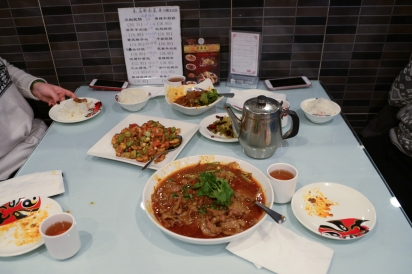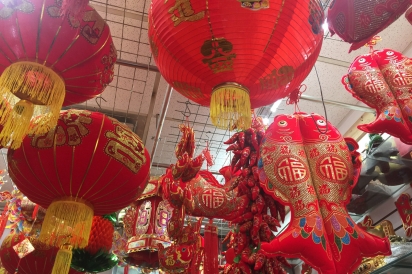Flushing Restaurant Owners Welcome the Year of the Dog
On a recent Sunday inside the brightly lit Szechuan House, manager Lisa Li is taking calls for delivery just a few minutes after opening. A Chinese soap opera plays on the TV and Lunar New Year decorations line the wall and ceiling.
The restaurant inside a four-story small strip of Roosevelt Avenue near Prince Street opened in 1985, when it was a much different Flushing. They were one of the first in the neighborhood to serve cuisine from the Sichuan province, coming in as the area’s Chinese community was steadily growing.It’s changed its name a few times over three decades, but Szechuan House has remained as the recent development boom has brought massive residential towers to Flushing’s streets.
Looking at all of the construction, it’s been a prosperous few years in the neighborhood.
The glass towers of the nearby Sky View development—with hundreds of luxury apartments—are anchored by shops and offices. Just a few steps from Szechuan House is One Fulton Square, an estimated $145 million project with a hotel, retail and luxury condos.
And the more than a million-square-foot Tangram project will include luxury condos, a hotel, shops and business opportunities within its glass walls.
“Now that Flushing is growing faster and faster, it shows that it is a great place to attract many people from all over the world for development and tourism,” Li, 45, said through a translation app on her iPhone, as she snuck in bites of breakfast between working.
But it’s created more competition, more overcrowding and fears of unaffordability as housing prices shoot up, she said.
Queens—lifted by many upcoming projects in Flushing—is close to Brooklyn in terms of the most expensive condo projects in the city, according to an analysis from The Real Deal.
“This is good for restaurants, but also bad,” Li added. Customers still flock to the restaurant, which has been ranked as one of the best in the country for serving the spicy, peppery Szechuan food.
“It’s a challenge for these old shops. Rent rises, wages are rising. Therefore we must keep the quality and the service to better meet the challenges.”
This Saturday, thousands of people are expected at the Lunar New Year parade—which has grown as the neighborhood around it has, too.
Peter Tu, 62, is a leader in the Flushing Chinese Business Association and he holds court from their third-floor office overlooking Main Street. He’s also one of the many organizers of the parade, which celebrates both the Chinese and Korean New Year.
It’s also a celebration of the neighborhood’s diversity. “We want this culture to be a part of the American culture,” he said.
“There’s no requirement for a party, no skin color, no origin. You just want to join the parade.”
New developers take part in the parade, with floats that cost thousands of dollars. The economic success of the community has helped it grow without government funding, Tu said—which is something he’s proud of.
For the first time ever there will also be a stage outside the Queens Library on Main Street. It’s a way for the organizers to show how well the community is doing, to show how these immigrants have fulfilled the American dream, Tu said.
“When I came to the United States in 1980, Flushing was a small town,” he said. “Nobody guessed after 20, 30 years it could be like this. Nobody would guess it could be like a middle city.”
The wood-paneled Kanes Diner opened more than 50 years ago on College Point Boulevard, and Jose Paulino has worked there for more than 30 years.
Standing at the counter, as “Days of Our Lives” played on the television behind him, he gestured across the street to Sky View and other construction projects.
“There was nothing here,” the 58-year-old chef said. Now, a new apartment building looms over the brown and red diner, which is lined with signed headshots and photos and framed articles ranking them as the best diner in the city.
“I think it’s very good for the economy,” he said. “It’s good, there are more customers. It’s really making business better.”
Waitress Tiffany Morsette, 23, who’s worked at the diner since she was 15, said they get developers coming in to make offers on their space.
“People try to buy the lot, they offer money for the diner,” she said, noting they’re the only diner left in the neighborhood. They have no plans to sell the 24-hour diner, which is busy all day and night.
“You expect to see change. It’s New York,” she said. “It’s not going to get any smaller.”
Szechuan House | @szechuan_house
Flushing Chinese Business Association
Queens Library | @queenslibrary
Kanes Diner













